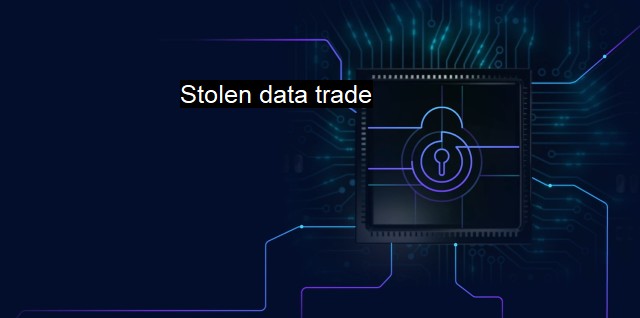What is Stolen data trade?
The Rising Threat of the Stolen Data Trade in the Digital Era: A Profound Concern for Cybersecurity and Antivirus Applications
Stolen data trade refers to an illicit industry flourishing in the dark corners of the internet, where sensitive information is bought, sold or exchanged. Given the increasing dependency on digital platforms for the exchange of information, cybersecurity has emerged as a critical concern. Phishing, malware attacks, data breaches, and different forms of cyber-attacks have endangered personal, professional, and even national security-related data. These stolen data parked in the cyber underground world can later facilitate numerous illegal activities, including identity theft, financial fraud, corporate espionage, and even cyber warfare.Awareness about stolen data trade is fundamental to understanding its scope, consequences, and countermeasures. Notably, the value of stolen data on the cyber underground market largely depends on its potential to be abused for illegal purposes. Personal data such as Social Security Numbers, credit card details, addresses, passwords, and health records command high prices since they can directly facilitate financial theft.
Data expropriated from business houses often include detailed customer lists, corporate strategies, negotiation tactics, intellectual manufacturing processes and the like, which can cause significant harm to the business. Not only does it expose them to significant financial losses but also it can detrimentally impact their market reputation. Likewise, national security data can compromise a nation’s integrity and sovereignty.
Interestingly, the stolen data trade doesn't always entail direct monetary exchange. In many instances, bartering of one stolen data set for another is also witnessed. some adopt this route to attain fame within the hacker community or use it as a gateway to more complex hacking practices.
The sophistication and audacity of cybercriminals engaged in stolen data trade have burgeoned due to the anonymity rendered by the internet, particularly the so-called 'dark web'. The dark web is a highly encrypted space within the internet, effectively inaccessible to search engines and only accessible through specific software. Crime-as-a-service (CaaS) is another burgeoning trend in the stolen data trade, where cybercriminals offer their "services" for a fee, or even provide on demand tailor-made cyber threat solutions.
To counter stolen data trade, robust preventive and prophylactic measures are required. Effective cybersecurity practices and efficient anti-virus software potentially form the first line of defense. Antivirus software should be up-to-date, tracking and responding to the latest malware, ransomware, and virus to ensure one’s data is well protected. Data encryption and utilization of secure networks can further enhance data security.
Training humans also dwell in the center of tackling this challenge. Regular awareness programs can help in identifying possible phishing efforts, recognizing dodgy links, and adopting best internet practices. Data protection laws also play a significant role.
Equally important are responses in the aftermath of data theft. Initial steps often include determining the extent of the damage and identifying the compromised data, usually by computer forensics. Reporting to local law enforcement agencies and updating customers is often legally, if not ethically, mandated. Legal recourse varies by country. In many instances, professionals specializing in cyber risk management and cyber insurance providers will be called upon.
Combating stolen data trade demands a comprehensive approach that includes appropriate legislation, strict enforcement, cutting-edge technology in terms of cybersecurity and antivirus, and reinforced by an aware and empowered user base. Policymakers, tech companies, legal experts and end-users, all have a coherent role to combat this scourging hazard threatening the digital ecosystem. Despite the challenges involved, these concerted efforts give hope of a safer digital future, where the sanctity of personal, professional, and national security-related data is preserved.

Stolen data trade FAQs
What is stolen data trade?
Stolen data trade is the illegal sale and purchase of sensitive information that has been obtained through cyberattacks or data breaches. Cybercriminals often steal personal or financial data, such as credit card numbers, passwords, and social security numbers, and then sell this data to others on the dark web.How does stolen data trade affect businesses?
Stolen data trade can have serious consequences for businesses, as they may face financial loss, damage to reputation, and legal liability if customer data is compromised. It is important for businesses to implement strong cybersecurity measures, such as antivirus software and employee training, to protect against cyberattacks and data breaches.Can antivirus software prevent stolen data trade?
While antivirus software can help detect and block known malware and viruses, it may not be enough to prevent stolen data trade. Cybercriminals can use a variety of tactics to obtain sensitive data, such as phishing scams and social engineering, which may bypass antivirus software. However, having antivirus software is still an important part of a comprehensive cybersecurity strategy.What should individuals do if they suspect their data has been stolen and is being traded?
Individuals who suspect that their personal data has been stolen and is being traded should immediately contact their bank or credit card company to report any suspicious activity. They should also monitor their credit reports and consider placing a credit freeze on their accounts to prevent further unauthorized access. It is also recommended to report the incident to law enforcement and seek guidance from a cybersecurity professional.| | A | | | B | | | C | | | D | | | E | | | F | | | G | | | H | | | I | | | J | | | K | | | L | | | M | |
| | N | | | O | | | P | | | Q | | | R | | | S | | | T | | | U | | | V | | | W | | | X | | | Y | | | Z | |
| | 1 | | | 2 | | | 3 | | | 4 | | | 7 | | | 8 | | |||||||